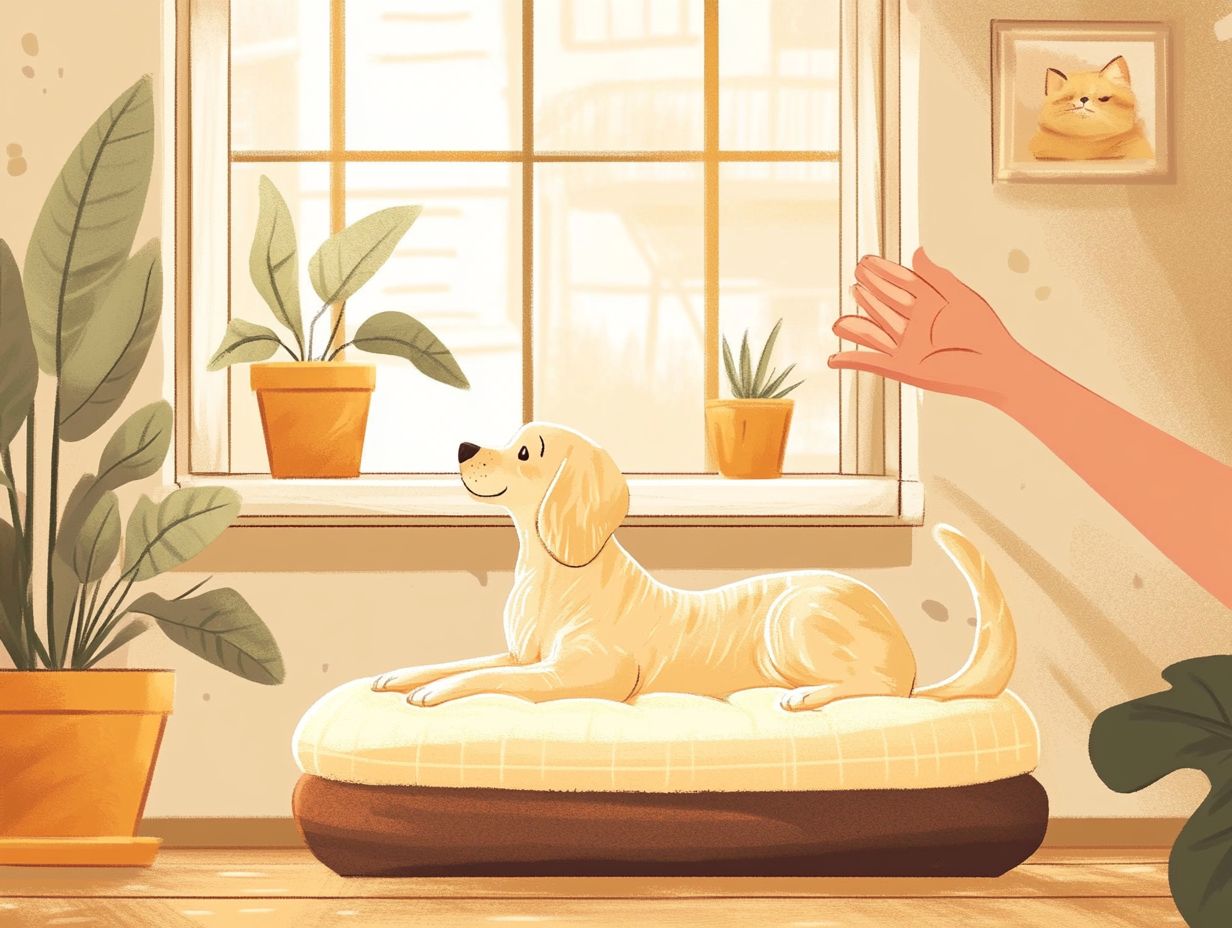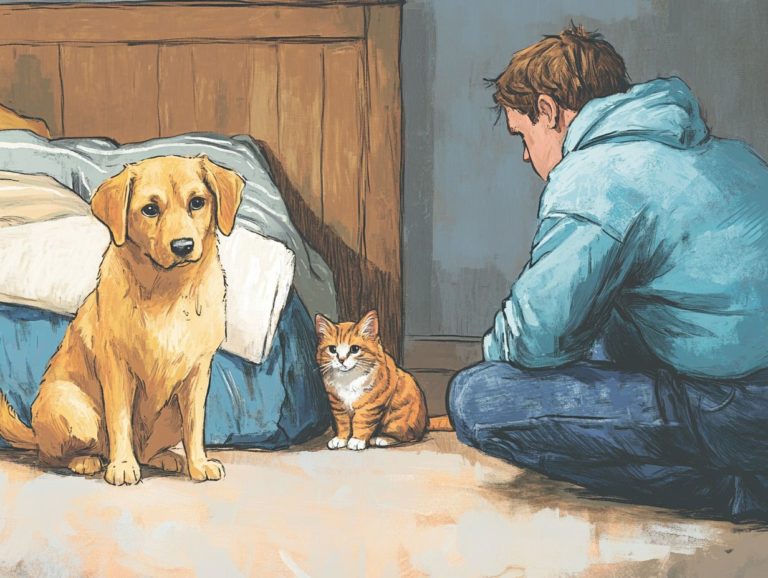How to Foster a Positive Environment for Anxious Pets?
Creating a nurturing environment for pets is essential! Your furry friends deserve a calm life! Let s dive into how to achieve this.
Pets are keenly attuned to their surroundings. A supportive space can significantly enhance their emotional well-being. This article delves into how different aspects of the environment can affect anxious pets and offers insights on designing calming spaces, establishing consistent routines, and employing effective strategies to alleviate their fears.
Contents
- Key Takeaways:
- The Impact of Environment on Anxious Pets
- Creating a Calming Space for Anxious Pets
- Establishing a Routine for Anxious Pets
- Effective Strategies for Reducing Anxiety in Pets
- Frequently Asked Questions
- What does it mean to foster a positive environment for anxious pets?
- Why is it important to foster a positive environment for anxious pets?
- What are some ways to foster a positive environment for anxious pets?
- Can socialization help foster a positive environment for anxious pets?
- How can I communicate with my pet to foster a positive environment?
- Are there any supplements or medications that can help foster a positive environment for anxious pets?
Key Takeaways:

- Understanding the impact of environment on pet anxiety is crucial for creating a positive space.
- Designing a safe environment and establishing a routine reduces anxiety.
- Using behavior techniques, natural remedies, and professional help can effectively decrease anxiety.
The Impact of Environment on Anxious Pets
The environment significantly influences the emotional well-being of anxious pets, especially dogs that frequently experience separation anxiety triggered by various stressors in their surroundings.
A poorly designed space can increase feelings of fear and uncertainty. This often leads to unwanted behaviors.
Conversely, a thoughtfully curated environment fosters comfort and security. It enables pets to self-soothe and flourish.
Recognizing elements like noise, clutter, and unsafe areas is key. Creating a sanctuary boosts your pet’s security and aligns with their natural instincts.
Understanding the Role of Environment in Pet Anxiety
Understanding how the environment affects pet anxiety is crucial for you as a dog owner, especially regarding your pet’s separation anxiety issues.
Creating a comfortable environment involves more than just the physical space; it requires crafting an emotional environment where your pet feels secure and relaxed.
Various environmental factors like noise levels and even the arrangement of your furniture can significantly influence your dog’s well-being. For instance, excessive background noise can elevate stress levels, making it difficult for sensitive dogs to find their peace.
Establishing a safe space, perhaps an inviting corner with cozy bedding, can offer a retreat where your pet can escape from disturbing stimuli.
By fostering these enriching living areas, you can help alleviate anxiety over time. This promotes healthier behaviors and strengthens the bond between you and your furry companion.
Creating a Calming Space for Anxious Pets
Creating a calming space for your anxious pets is essential! It’s about crafting an atmosphere that fosters relaxation and security, allowing your dogs and other pets to self-regulate their emotions. For more guidance, explore techniques for building a bond with anxious pets.
A thoughtfully designed relaxation station serves as a sanctuary, incorporating elements like calming aids, a cozy dog bed, and strategically placed calming scents, like pheromones, which help reduce anxiety.
You might also consider adding sound elements, such as classical music or white noise, to buffer against outside disturbances.
Incorporating positive reinforcement techniques enhances the comfort and safety of this space. It becomes an essential aspect of managing separation anxiety.
Designing a Safe and Comfortable Environment

Designing a safe and comfortable environment for your anxious pets requires an overall strategy that takes into account all sensory inputs, especially for dogs with noise sensitivity. For specific guidance, consider exploring how to help a rescue pet with anxiety.
To create this peaceful haven, think about adding soundproofing elements such as thick curtains, plush rugs, and acoustic panels that effectively absorb and dampen outside noise. Opting for calming aids, like soft lighting and soothing colors, will help establish an inviting atmosphere that encourages relaxation.
The arrangement of furniture matters too; make sure to provide comfortable places for your pets to retreat to think secluded corners or enclosed spaces as these can significantly reduce stress levels. Tailoring the setup to their individual preferences, such as including favorite toys or blankets, will help create a familiar, comforting area that minimizes things that make them anxious and fosters a strong sense of security.
Establishing a Routine for Anxious Pets
Establishing a routine for your anxious pets is essential for fostering a sense of security and predictability, particularly for dogs grappling with separation anxiety. A clear daily schedule gives them the stability they need, allowing them to anticipate what comes next, which in turn helps to reduce their anxiety levels.
This routine should include feeding times, exercise sessions, and engaging mental stimulation activities all of which contribute to a sense of normalcy. By adhering to this schedule, your pets will learn to self-soothe and regulate their behavior more effectively.
The Importance of Consistency and Predictability
The significance of consistency and predictability is paramount when you’re managing anxious pets, especially those grappling with separation anxiety.
Establishing a reliable daily routine creates a structured environment where your pets can look forward to specific behaviors and activities, instilling a sense of security. For example, by scheduling regular feeding times, daily walks, and consistent play sessions, you not only help your pets feel grounded but also strengthen the bond you share with them.
You can also include calming activities, such as puzzle toys or training sessions throughout the day, to further ease their tension and encourage positive behavior. If you’re wondering what to do if your pet is anxious after moving, this structured framework acts as a comforting guide, allowing anxious pets to navigate their day with reduced fear and uncertainty, ultimately fostering a more harmonious living situation for both you and your beloved companions.
Effective Strategies for Reducing Anxiety in Pets
To effectively reduce anxiety in your pets, consider a multi-faceted approach that integrates training techniques, enrichment activities, and behavioral support. For specific strategies, refer to these tips for training anxious pets at home. This holistic method gives your pets the power to self-regulate and cultivate healthier responses to stressors, fostering a calmer and more balanced environment for them.
Behavior Modification Techniques

Behavior modification techniques are crucial for tackling the root causes of separation anxiety, helping pets adapt more seamlessly to their environments.
By incorporating these techniques, you can significantly enhance your pet’s overall well-being, allowing them to feel more at ease when left alone. For example, desensitization gradually exposes your furry friend to the triggers that spark their anxiety, effectively reducing their emotional response over time. When combined with counter-conditioning, which shifts your pet s negative associations with being alone to more positive experiences, this method cultivates a sense of security.
Positive reinforcement is pivotal in this journey; by rewarding desired behaviors, you can encourage your companion to embrace independence, ensuring smoother transitions for both your pet and your family.
Natural Remedies and Supplements
Natural remedies and supplements can significantly alleviate anxiety in your pets, offering a complementary approach to training methods.
These holistic treatments can prove especially effective for pets who feel stressed during travel, loud noises, or shifts in their environment. Consider exploring options like pheromones, which are substances that mimic soothing natural scents to help calm an anxious pet.
Herbal supplements such as valerian and chamomile can promote relaxation. Aromatherapy with calming scents like lavender may help create a tranquil atmosphere in your home.
By integrating these remedies into your pet’s routine, you foster emotional balance and enhance their overall well-being, helping them feel secure and happy.
Professional Help and Medications
In situations where anxiety is particularly severe, seeking professional help and considering medications can provide crucial support for pets struggling with separation anxiety.
Veterinary professionals can be your best allies in understanding your pet’s needs, offering customized treatment plans that may blend behavioral therapies with medications to effectively tackle their specific challenges.
These interventions relieve immediate symptoms and bolster your pet’s overall ability to cope, enabling them to navigate stressful situations with greater ease.
By partnering with a qualified veterinarian, you can access invaluable insights and strategies. This paves the way for your furry companion to enjoy a more balanced and relaxed life, ultimately strengthening the bond you share.
Frequently Asked Questions
What does it mean to foster a positive environment for anxious pets?

Fostering a positive environment for anxious pets means creating a space that is calm, safe, and comforting for pets who struggle with anxiety. This can include implementing strategies to help an anxious pet adjust and techniques to help ease their fears.
Why is it important to foster a positive environment for anxious pets?
Anxious pets can experience a range of negative emotions and behaviors that can harm their overall well-being. By fostering a positive environment and utilizing strategies like positive reinforcement for anxious pets, you can help reduce their anxiety and promote a sense of security and happiness for your pet.
What are some ways to foster a positive environment for anxious pets?
There are several ways to create a positive environment for anxious pets. These include providing a safe and quiet space for them, using calming scents or music, implementing a consistent routine, and incorporating techniques to help your anxious pet feel safe through positive reinforcement training.
Yes, socialization can be a key aspect of fostering a positive environment for anxious pets. Introducing them to new people and animals in a controlled and positive manner can help them feel more comfortable and confident in various situations. For more insights, consider exploring understanding the needs of anxious pets.
How can I communicate with my pet to foster a positive environment?
Communication is crucial when fostering a positive environment for anxious pets. It’s essential to understand your pet’s body language and reactions to different situations. For more insights, check out helpful tips for reducing pet anxiety. Use positive reinforcement and consistent cues to communicate with them effectively.
Are there any supplements or medications that can help foster a positive environment for anxious pets?
Various supplements and medications are available to help reduce anxiety and promote a positive environment for anxious pets. However, it’s essential to consult with a veterinarian before giving your pet any medications to ensure safety and appropriateness for their specific needs.






